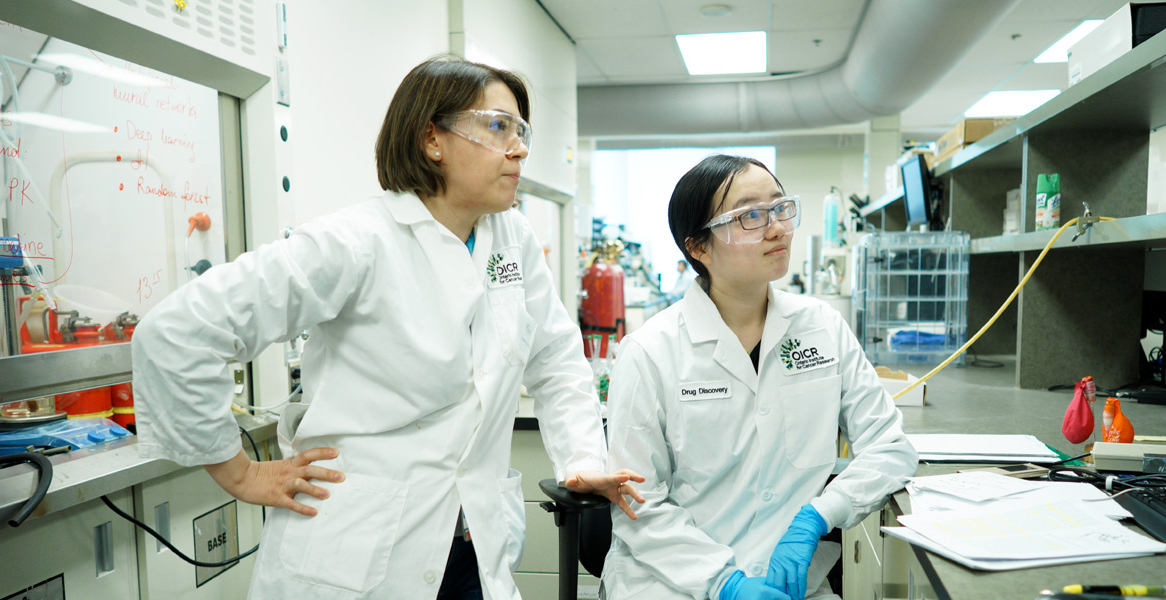OICR’s Drug Discovery team and Princess Margaret Cancer Centre researchers collaborate to turn a research discovery into a potential cancer breakthrough
For more than three decades, researchers have tried to develop drugs that target the MYC oncoprotein – a protein that can contribute to half of all cancers – but traditional approaches to blocking MYC have not been successful. The structure of the MYC protein makes it ‘undruggable’; it cannot be blocked by a small molecule or a drug, so new strategies to inhibit the activity of this protein are needed.
Dr. Linda Penn, Senior Scientist at the Princess Margaret Cancer Centre, recently discovered a new way of preventing MYC from promoting cancer growth by stopping the interaction between the MYC protein and a ‘druggable’ partner protein, G9a.

“We investigated MYC and discovered G9a as a key partner protein. We blocked G9a using both genetic and pharmacological strategies. We saw that inhibiting G9a using an inducible knockdown strategy had the potential to melt tumour cells away,” says Penn. “But for some reason, no matter what we tried, we didn’t see the tumour-fighting effect of the G9a compound inhibitor in animal models. Something didn’t line up.”
A discovery like Penn’s, however, can only be brought to patients if it can first be demonstrated in living experimental models, also known as in vivo. The results of Penn’s in vivo experiments were inconclusive, preventing her from publishing her promising findings in a top-tier journal and advancing this line of research.
Navigating the preclinical minefield
The compound – or molecule – that Penn’s team was using to block G9a in vitro wasn’t doing the same in vivo and they didn’t understand why. Lacking the medicinal chemistry expertise needed to solve this problem, Penn turned to OICR’s Drug Discovery group.

“All of Dr. Penn’s experiments and all of the published literature implies that the compound should have worked, but unfortunately that wasn’t her observation,” says Dr. Ahmed Aman, Principal Research Scientist in the Drug Discovery group at OICR. “We had to break this problem down and solve it methodically while considering the various factors that could have contributed to these results.”
The Drug Discovery team evaluated the compound and found that it didn’t have the drug-like properties necessary to demonstrate activity in vivo. More specifically, they discovered that the compound would break down in the body before having a chance to inhibit G9a. Although the compound that they tested would not be useable as a drug, Penn’s study was now conclusive. Finding the missing piece of the puzzle allowed her team to publish their discovery in Cancer Cell and proceed with identifying and investigating new compounds to target G9a more effectively.
Collaboration to translation
Penn says that she worked with the Drug Discovery group because of their stellar reputation in the industry, strong track record and unique expertise.
“Without the Drug Discovery team, I really don’t know where I would have gone,” says Penn. “I simply didn’t have established relationships with medicinal and analytical chemists nor private industry to help me solve these chemistry problems.”
Together, Penn and the Drug Discovery group are continuing to investigate G9a and how to block it from interacting with the MYC protein. They are using another reported G9a inhibitor, which has been prepared in-house by the Drug Discovery team that Aman says should be able to work much more effectively in vivo.
“Our collaboration with the Penn group is a great example of how we hope to leverage our drug discovery capabilities to support investigators across Ontario and advance their research efforts,” says Dr. Rima Al-awar, Director and Senior Principal Investigator of OICR’s Drug Discovery group.
Learn more about OICR’s Drug Discovery services and capabilities through the Collaborative Research Resources directory.

